History
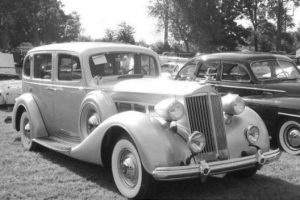 These days, driving our cars everywhere we go, there are certain amenities in our cars that we take for granted, but that in reality, we just couldn’t live without. One of those amenities is the automobile air conditioner. Summers would be just miserable without air conditioning in the car. While a company in New York City first offered installation of air conditioning for cars in 1933. Most of their customers operated limousines and luxury cars. I don’t suppose too many people could afford to add that to their car. Then, in 1939, Packard became the first automobile manufacturer to offer an air conditioning unit in its cars. I’m sure that everyone who could afford to buy a car that year, was really excited about the possibilities.
These days, driving our cars everywhere we go, there are certain amenities in our cars that we take for granted, but that in reality, we just couldn’t live without. One of those amenities is the automobile air conditioner. Summers would be just miserable without air conditioning in the car. While a company in New York City first offered installation of air conditioning for cars in 1933. Most of their customers operated limousines and luxury cars. I don’t suppose too many people could afford to add that to their car. Then, in 1939, Packard became the first automobile manufacturer to offer an air conditioning unit in its cars. I’m sure that everyone who could afford to buy a car that year, was really excited about the possibilities.
The cars were manufactured by Bishop and Co, of Cleveland, Ohio. The “Bishop and Babcock Weather Conditioner” also incorporated a heater. This looked like a perfect car. Cars ordered with the new “Weather Conditioner” were shipped from Packard’s East Grand Boulevard facility to the B&B factory where the conversion was performed. Once complete, the car was shipped to a local dealer where the customer would take delivery. There were some drawbacks, however. When you think about automobile air conditioning and heat, you immediately think what drawback could there be?
Packard fully warranted and supported this conversion, and marketed it well. However, it was not commercially successful for a number of reasons. The main evaporator and blower system took up half of the trunk space. That problem was alleviated as trunks became larger in the post-war period. The system became outdated by more efficient systems in the post-war years. The original system had no temperature thermostat or shut-off 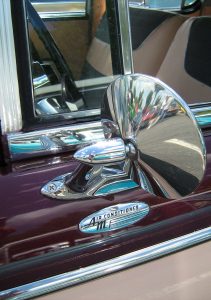 mechanism other than switching the blower off, and even with the switch off, cold air would still sometimes enter the car with any movement as the drive belt was continuously connected to the compressor. Systems designed later would use electrically operated clutches to remedy this problem. The several feet of plumbing going back and forth between the engine compartment and trunk proved unreliable in service. Probably the biggest deterrent was the price, at $274, which would be over $4,692.12 in 2014 US dollars today, it was not affordable to most people in post-depression/pre-war America, but I doubt if the fact that you had to turn off the engine and get out of the car to flip the switch, located in the trunk made it impractical for the most part, and because it also had to be turned off the same way,and with no adjustment, it was something you had to do often. The option was discontinued after 1941. Of course, as you all know, while this version was discontinued in 1941, the air conditioner was not, because we all have a much more efficient version in our automobiles today.
mechanism other than switching the blower off, and even with the switch off, cold air would still sometimes enter the car with any movement as the drive belt was continuously connected to the compressor. Systems designed later would use electrically operated clutches to remedy this problem. The several feet of plumbing going back and forth between the engine compartment and trunk proved unreliable in service. Probably the biggest deterrent was the price, at $274, which would be over $4,692.12 in 2014 US dollars today, it was not affordable to most people in post-depression/pre-war America, but I doubt if the fact that you had to turn off the engine and get out of the car to flip the switch, located in the trunk made it impractical for the most part, and because it also had to be turned off the same way,and with no adjustment, it was something you had to do often. The option was discontinued after 1941. Of course, as you all know, while this version was discontinued in 1941, the air conditioner was not, because we all have a much more efficient version in our automobiles today.
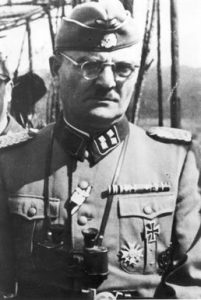 The horrors of the Nazis were many, but the worst were what they did to the Jewish people. The gas chambers and the labor camps, experimentation and beatings, were horrible, and this only names a few of the things they did. Hitler was intent on killing as many Jews as he could, and he didn’t care how it got done, as long as it got done. One of the worst, in fact the second worst event of World War II, exceeded only by the 1941 Odessa massacre. The Aktion Erntefest, which translates to Operation Harvest Festival was the murder of 42,000 Jews at the same time. How anyone could call something like that a “festival” is beyond me.
The horrors of the Nazis were many, but the worst were what they did to the Jewish people. The gas chambers and the labor camps, experimentation and beatings, were horrible, and this only names a few of the things they did. Hitler was intent on killing as many Jews as he could, and he didn’t care how it got done, as long as it got done. One of the worst, in fact the second worst event of World War II, exceeded only by the 1941 Odessa massacre. The Aktion Erntefest, which translates to Operation Harvest Festival was the murder of 42,000 Jews at the same time. How anyone could call something like that a “festival” is beyond me.
The action was set in motion by the SS and Order Police, and the Ukrainian Sonderdienst formations in the General Government territory of occupied Poland. The murder of the Jewish laborers in concentration camp Lublin/Majdanek and the forced-labor camps Trawniki and Poniatowa was an unfathomable atrocity. The murders were 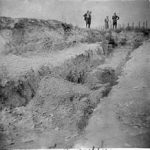 performed in retaliation for the uprisings at the Treblinka and Sobibor killing centers and the Warsaw, Bialystok, and Vilna ghettos that had led to increased concerns about Jewish resistance. To prevent further resistance, SS chief Heinrich Himmler ordered the killing of surviving Jews in the Lublin District of German-occupied Poland. Most of the remaining Jews were employed in forced-labor projects and were concentrated in the Trawniki…at least 4,000 people, Poniatowa…at least 11,000 people, and Majdanek…about 18,000 people. They were killed at Majdanek, near Lublin on November 3rd and 4th, 1943.
performed in retaliation for the uprisings at the Treblinka and Sobibor killing centers and the Warsaw, Bialystok, and Vilna ghettos that had led to increased concerns about Jewish resistance. To prevent further resistance, SS chief Heinrich Himmler ordered the killing of surviving Jews in the Lublin District of German-occupied Poland. Most of the remaining Jews were employed in forced-labor projects and were concentrated in the Trawniki…at least 4,000 people, Poniatowa…at least 11,000 people, and Majdanek…about 18,000 people. They were killed at Majdanek, near Lublin on November 3rd and 4th, 1943. 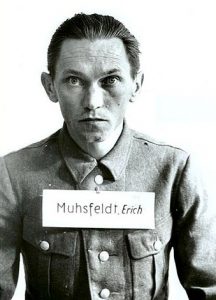 The SS shot them in large prepared ditches outside the camp fence near the crematorium. Jews from other labor camps in the Lublin area were also taken to Majdanek and shot. Loud music was played through speakers at both Majdanek and Trawniki to drown out the noise of the mass shootings. The killing at Majdanek was the largest single-day, single-location massacre during the Holocaust.
The SS shot them in large prepared ditches outside the camp fence near the crematorium. Jews from other labor camps in the Lublin area were also taken to Majdanek and shot. Loud music was played through speakers at both Majdanek and Trawniki to drown out the noise of the mass shootings. The killing at Majdanek was the largest single-day, single-location massacre during the Holocaust.
On the orders of Christian Wirth and Jakob Sporrenberg, the approximately 42,000 to 43,000 Jews were gunned down, and dumped in the ditches. It was not only retaliation for actions of rebellion, but probably also a way to deter any further resistance among the other Jews. The fact that the Jews were viewed an non-humans, made it easier to kill them, I suppose, but the killing were beyond horrible to most decent people, but to the Nazis it was almost considered sport or at the very least fun. To anyone who values human life, it was totally horrific.
 The inspiration for inventions comes from many different sources, and things we would never think could turn into something great, can surprise you. Swiss electrical engineer, George De Mestral had gone for a walk in the woods with his dog, When they got back, De Mestral found himself fascinated with the cockleburs that he had to pull off of his dog. After taking a walk in the woods with his dog, was fascinated by the cockleburs’ ability to cling to his clothes and his dog’s fur. For many dog owners cockleburs are a good reason to grumble. When their pets play outside and return with all sorts of nature stuck to their fur and feet, bringing the outside environment into their once-clean homes, people get annoyed. Nevertheless, not everyone saw this as a big problem.
The inspiration for inventions comes from many different sources, and things we would never think could turn into something great, can surprise you. Swiss electrical engineer, George De Mestral had gone for a walk in the woods with his dog, When they got back, De Mestral found himself fascinated with the cockleburs that he had to pull off of his dog. After taking a walk in the woods with his dog, was fascinated by the cockleburs’ ability to cling to his clothes and his dog’s fur. For many dog owners cockleburs are a good reason to grumble. When their pets play outside and return with all sorts of nature stuck to their fur and feet, bringing the outside environment into their once-clean homes, people get annoyed. Nevertheless, not everyone saw this as a big problem.
When De Mestral looked at the cockleburs under a microscope, he saw the tons of tiny hooks that line cockleburs and discovered they could easily attach to the small loops found in clothing and fur. De Mestral saw this as a opportunity to invent something useful. He experimented with different materials to make his own hooks and loops form a stronger bond. In 1955, after much trial and error, De Mestral decided nylon was perfect and thus Velcro was invented. These days, Velcro is a vital part of everyday life. We use it all the time, and give no thought to life without it.
The word Velcro is a combination of the words “velvet” and “crochet,” and was showcased in a 1959 fashion  show held at the Waldorf-Astoria Hotel in New York City. However, it didn’t receive positive reviews from fashion enthusiasts. I’m sure they thought it would snag material, and pull hair, which it can do, but its positive uses far outweigh its negative issues. Nevertheless, Velcro wasn’t widely used until NASA made it popular in the early 1960s. Apollo astronauts used it to secure items that they didn’t want escaping in their zero-gravity environment. Hospitals and athletic companies eventually used Velcro after realizing the practicality of the material. In 1968, Puma was the first to use Velcro on shoes. Adidas, Reebok, and others followed suit. Today it is used in many things, including the blood pressure cuff. it has simplified our lives immensely, and to think that it was invented by accident.
show held at the Waldorf-Astoria Hotel in New York City. However, it didn’t receive positive reviews from fashion enthusiasts. I’m sure they thought it would snag material, and pull hair, which it can do, but its positive uses far outweigh its negative issues. Nevertheless, Velcro wasn’t widely used until NASA made it popular in the early 1960s. Apollo astronauts used it to secure items that they didn’t want escaping in their zero-gravity environment. Hospitals and athletic companies eventually used Velcro after realizing the practicality of the material. In 1968, Puma was the first to use Velcro on shoes. Adidas, Reebok, and others followed suit. Today it is used in many things, including the blood pressure cuff. it has simplified our lives immensely, and to think that it was invented by accident.
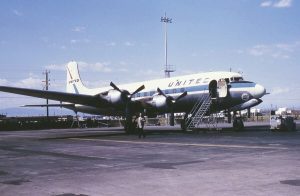 Most plane crashes are caused by pilot error or mechanical failure, but sometimes, someone commits an act of terrorism, or as in the case of United Airlines Flight 629 someone commits an act of hatred aimed at one person. These acts are never rational, and this one certainly wasn’t, because Jack Gilbert Graham was not a rational man. I think many, if not most of us have thought at one point or another that our parents were somehow meaner to us than any other parent in the universe, but Jack Graham took that obsession to the next level. He decided that his mother was responsible for giving him a horrible childhood, and so he decided to take his revenge on her by placing a bomb in the luggage she was checking.
Most plane crashes are caused by pilot error or mechanical failure, but sometimes, someone commits an act of terrorism, or as in the case of United Airlines Flight 629 someone commits an act of hatred aimed at one person. These acts are never rational, and this one certainly wasn’t, because Jack Gilbert Graham was not a rational man. I think many, if not most of us have thought at one point or another that our parents were somehow meaner to us than any other parent in the universe, but Jack Graham took that obsession to the next level. He decided that his mother was responsible for giving him a horrible childhood, and so he decided to take his revenge on her by placing a bomb in the luggage she was checking.
His mother, Daisie Eldora King, who was a 53 year old Denver businesswoman was en route to Alaska to visit her daughter. Her flight United Airlines Flight 629, registration N37559, was a Douglas DC-6B aircraft also known as “Mainliner Denver.” The flight had originated at New York City’s La Guardia Airport and made a scheduled stop in Chicago before continuing to Denver’s Stapleton Airfield and landed at 6:11pm, 11 minutes late. At Denver the aircraft was refueled with 3,400 US gallons of fuel, and had a crew replacement. Captain Lee Hall, who was a World War II veteran, assumed command of the flight for the segments to Portland and 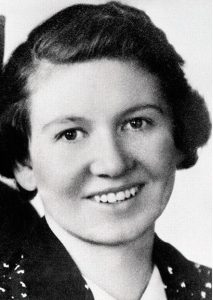 Seattle. The flight took off at 6:52pm and at 6:56pm made its last transmission stating it was passing the Denver omni. Seven minutes later, the Stapleton air traffic controllers saw two bright lights suddenly appear in the sky north-northwest of the airport. Both lights were observed for 30 to 45 seconds, and both fell to the ground at roughly the same speed. The controllers then saw a very bright flash originating at or near the ground, intense enough to illuminate the base of the clouds 10,000 feet above the source of the flash. Upon observing the mysterious lights, the controllers quickly determined there were no aircraft in distress and contacted all aircraft flying in the area; all flights were quickly accounted for except for United Flight 629. The date was November 1, 1955.
Seattle. The flight took off at 6:52pm and at 6:56pm made its last transmission stating it was passing the Denver omni. Seven minutes later, the Stapleton air traffic controllers saw two bright lights suddenly appear in the sky north-northwest of the airport. Both lights were observed for 30 to 45 seconds, and both fell to the ground at roughly the same speed. The controllers then saw a very bright flash originating at or near the ground, intense enough to illuminate the base of the clouds 10,000 feet above the source of the flash. Upon observing the mysterious lights, the controllers quickly determined there were no aircraft in distress and contacted all aircraft flying in the area; all flights were quickly accounted for except for United Flight 629. The date was November 1, 1955.
The plane was blown up over Longmont, Colorado at about 7:03pm local time, while en route from Denver, Colorado, to Portland, Oregon, and Seattle, Washington. All 39 passengers and five crew members on board were killed in the explosion and crash. There was early speculation that something other than a mechanical problem or pilot error was responsible, given the magnitude of the in-air explosion. Investigators determined that Jack Gilbert Graham was responsible for bombing the airplane to kill his mother as revenge for his childhood and to obtain a large life insurance payout. Within 15 months of the explosion, Graham, who already had an extensive criminal record, was tried, convicted, and executed for the crime.
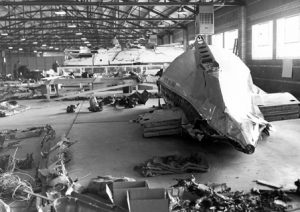 It was a horrible thing. One sick man committed murder in the skies, by killing his mother with a bomb, and in the process killed 41 other people too. I don’t know if he though the could really get away with it, but investigations are pretty sophisticated…even back then. It amazes me that they can take all those plane parts and examine them…somehow finding the source of the explosion, and tracing it back to the source. Then, by finding out who the luggage belonged to, they figured the whole thing out. Criminals really aren’t so smart, even though they think they have it all figured out. It is just sad that 42 people lost their lives, because some spoiled brat of a child thought his mom was too harsh when he was a kid…with no evidence to prove his point at all.
It was a horrible thing. One sick man committed murder in the skies, by killing his mother with a bomb, and in the process killed 41 other people too. I don’t know if he though the could really get away with it, but investigations are pretty sophisticated…even back then. It amazes me that they can take all those plane parts and examine them…somehow finding the source of the explosion, and tracing it back to the source. Then, by finding out who the luggage belonged to, they figured the whole thing out. Criminals really aren’t so smart, even though they think they have it all figured out. It is just sad that 42 people lost their lives, because some spoiled brat of a child thought his mom was too harsh when he was a kid…with no evidence to prove his point at all.
 The American Revolution was a serious embarrassment to Britain, and especially to King George III. The king had to admit that things weren’t going well in the colonies…at least not where Britain was concerned. By now, the colonists had signed the Declaration of Independence that summer, and they were not going to be moved from achieving their goal to be a sovereign nation.
The American Revolution was a serious embarrassment to Britain, and especially to King George III. The king had to admit that things weren’t going well in the colonies…at least not where Britain was concerned. By now, the colonists had signed the Declaration of Independence that summer, and they were not going to be moved from achieving their goal to be a sovereign nation.
On this day, October 31, 1776, the king give a speech to the British Parliament, telling them about the signing of the United States Declaration of Independence and the revolutionary leaders who signed it, saying, “for daring and desperate is the spirit of those leaders, whose object has always been dominion and power, that they have now openly renounced all allegiance to the crown, and all political connection with this country.” I’m sure he felt that the colonists were rebels, who were not worth wasting time on by now, and he 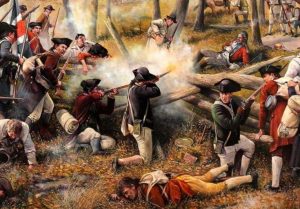 hoped he could walk away from them without losing face any more than he already had. The British never intended for the United States to be anything more than the colones. The king went on to inform Parliament of the successful British victory over General George Washington and the Continental Army at the Battle of Long Island on August 27, 1776, but warned them that, “notwithstanding the fair prospect, it was necessary to prepare for another campaign.” Somehow, the king had the idea that there was still hope to keep the colonies.
hoped he could walk away from them without losing face any more than he already had. The British never intended for the United States to be anything more than the colones. The king went on to inform Parliament of the successful British victory over General George Washington and the Continental Army at the Battle of Long Island on August 27, 1776, but warned them that, “notwithstanding the fair prospect, it was necessary to prepare for another campaign.” Somehow, the king had the idea that there was still hope to keep the colonies.
Despite George III’s harsh words, General William Howe and his brother, Admiral Richard Howe, still hoped to convince the Americans to rejoin the British empire in the wake of the colonists’ humiliating defeat at the Battle of Long Island. They hoped to do 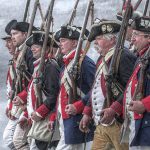 thing peacefully, but that was just not to be. The British could easily have prevented Washington’s retreat from Long Island and captured most of the Patriot officer corps, including the commander in chief. However, instead of forcing the former colonies into submission by executing Washington and his officers as traitors, the Howe brothers let them go with the hope of swaying Patriot opinion towards a return to the mother country. The Howe brothers’ attempts at negotiation failed, and the War for Independence dragged on for another four years, until the formal surrender of the British to the Americans on October 19, 1781, after the Battle of Yorktown. The freedom of the United States was not going to be taken from them…and that was a serious embarrassment to Britain.
thing peacefully, but that was just not to be. The British could easily have prevented Washington’s retreat from Long Island and captured most of the Patriot officer corps, including the commander in chief. However, instead of forcing the former colonies into submission by executing Washington and his officers as traitors, the Howe brothers let them go with the hope of swaying Patriot opinion towards a return to the mother country. The Howe brothers’ attempts at negotiation failed, and the War for Independence dragged on for another four years, until the formal surrender of the British to the Americans on October 19, 1781, after the Battle of Yorktown. The freedom of the United States was not going to be taken from them…and that was a serious embarrassment to Britain.
 Overdue is never a good thing, but there are some times when being overdue is a very bad thing. One of those times is when a plane, train, or ship are overdue. Andrea Gail began her final voyage departing from Gloucester Harbor, Massachusetts, on September 20, 1991, bound for the Grand Banks of Newfoundland off the coast of eastern Canada. After poor fishing, Captain Frank W “Billy” Tyne Jr headed east to the Flemish Cap where he believed they would have better luck. The fishing was much better there, and before long, the crew had filled the storage bins with fish. It was at that point that the ship’s ice machine began malfunctioning. Because they could not maintain the catch without the ice, Tyne set course for home on October 26–27.
Overdue is never a good thing, but there are some times when being overdue is a very bad thing. One of those times is when a plane, train, or ship are overdue. Andrea Gail began her final voyage departing from Gloucester Harbor, Massachusetts, on September 20, 1991, bound for the Grand Banks of Newfoundland off the coast of eastern Canada. After poor fishing, Captain Frank W “Billy” Tyne Jr headed east to the Flemish Cap where he believed they would have better luck. The fishing was much better there, and before long, the crew had filled the storage bins with fish. It was at that point that the ship’s ice machine began malfunctioning. Because they could not maintain the catch without the ice, Tyne set course for home on October 26–27.
The weather reports warned of dangerous weather conditions, and he knew it would be risky, but he thought they could make a run for home, and possibly beat the storm. The problem was that this was no ordinary storm. Two systems were colliding, and creating the perfect storm. It was the perfect situation for an impossible passage for the Andrea Gail. His friend, Linda Greenlaw, tried to warn Tyne not to try it. She was looking at the weather report and she could see that this storm was not one to be taken lightly. Nevertheless, Tyne headed for Massachusetts. His last reported transmission was at about 6:00pm on October 28, 1991, when he radioed Greenlaw, who was the Captain of the Hannah Boden, and gave his coordinates as 44°00 N 56°40 W, or about 162 miles east of Sable Island. He also gave a weather report indicating 30 foot seas and wind gusts up to 80 knots. Tyne’s final recorded words were “She’s comin’ on, boys, and she’s comin’ on strong.” It was reported that the storm created waves in excess of 100 feet in height, but ocean buoy monitors recorded a peak wave height of 39 feet, and so waves of 100 feet were deemed “unlikely” by Science Daily. However, data from a series of weather buoys in the general vicinity of the vessel’s last known location recorded peak wave action exceeding 60 feet in height from October 28 through 30, 1991.
The Andrea Gail was officially reported overdue on October 30, 1991. An extensive air and land search was launched by the 106th Rescue Wing from the New York Air National Guard, United States Coast Guard and Canadian Coast Guard forces. The search would eventually cover over 186,000 square nautical miles. Finally, on November 6, 1991, Andrea Gail’s emergency position-indicating radio beacon (EPIRB) was discovered 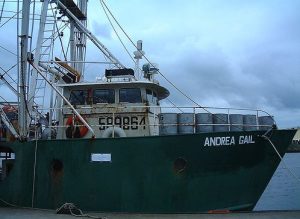 washed up on the shore of Sable Island in Nova Scotia…not the news they were hoping for. The EPIRB was designed to automatically send out a distress signal upon contact with sea water, but the Canadian Coast Guard personnel who found the beacon “did not conclusively verify whether the control switch was in the on or off position”. By November 9th, authorities officially called off the search for the missing Andrea Gail, due to the low probability of crew survival. Fuel drums, a fuel tank, the EPIRB, an empty life raft, and some other flotsam were the only wreckage ever found. The ship was presumed lost at sea somewhere along the continental shelf near Sable Island. Sometimes, overdue is the worst possible situation.
washed up on the shore of Sable Island in Nova Scotia…not the news they were hoping for. The EPIRB was designed to automatically send out a distress signal upon contact with sea water, but the Canadian Coast Guard personnel who found the beacon “did not conclusively verify whether the control switch was in the on or off position”. By November 9th, authorities officially called off the search for the missing Andrea Gail, due to the low probability of crew survival. Fuel drums, a fuel tank, the EPIRB, an empty life raft, and some other flotsam were the only wreckage ever found. The ship was presumed lost at sea somewhere along the continental shelf near Sable Island. Sometimes, overdue is the worst possible situation.
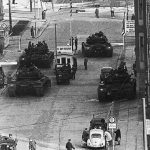 It seems there is always talk of the Third World War coming, and what might set it off. Most people hope that it stays all talk, because the weapons that are available these days could potentially wipe the human race off the planet, or at the very least, wipe whole nations off the map. Sometimes I wonder how we have avoided it so far, considering all the hate in the world today. Somehow our world leaders have held it off…for now. Nevertheless, there have been times when we have come very close to the last straw that would bring World War III. For 16 hours, between October 27 and October 28, 1961, at the height of the Cold War, US and Soviet tanks faced each other in divided Berlin in an action that brought the two superpowers closer to kicking off a third world war than in any other cold-war confrontation, with the exception of the Cuban missile crisis one year later. It was a very heated time in history.
It seems there is always talk of the Third World War coming, and what might set it off. Most people hope that it stays all talk, because the weapons that are available these days could potentially wipe the human race off the planet, or at the very least, wipe whole nations off the map. Sometimes I wonder how we have avoided it so far, considering all the hate in the world today. Somehow our world leaders have held it off…for now. Nevertheless, there have been times when we have come very close to the last straw that would bring World War III. For 16 hours, between October 27 and October 28, 1961, at the height of the Cold War, US and Soviet tanks faced each other in divided Berlin in an action that brought the two superpowers closer to kicking off a third world war than in any other cold-war confrontation, with the exception of the Cuban missile crisis one year later. It was a very heated time in history.
Washington and its British and French allies had failed to stop the Russians from building the Berlin Wall in August of 1961. By October, East German officials began to deny US diplomats the unhindered access to East Berlin that they were required to allow as part of the agreement with Moscow on the postwar occupation of Germany. Then, on 22 October, E Allan Lightner Jr, the senior US diplomat in West Berlin, was stopped by East German border guards on his way to the state opera house in East Berlin. The East Germans demanded to see his passport, which he insisted only Soviet officials had the right to check. The situation grew more heated with this exchange. Lightner was forced to turn back.
General Clay, who was an American hero of the 1948-1949 Berlin Airlift was sent by Washington to deal with the Russians after the erection of the Berlin Wall. He gave orders that the next American diplomat entering East Berlin be escorted by armed US army military police in jeeps. The maneuver succeeded, but the East Germans continued to attempt to assert their claim to control western allied officials entering East Berlin. Never one to suffer defeat easily, Clay ordered American M48 tanks to head for Checkpoint Charlie. There they stood, some 80 yards from the border, noisily racing their engines and sending plumes of black smoke into the night air. Alarmed by the apparent threat, Moscow, with the approval of the Soviet leader, Nikita Khrushchev, sent an equal number of Russian T55 tanks rumbling to face down the Americans. They too ground to a halt some 80 yards from the East/West Berlin border and, as with the US tanks they faced, stayed there for 16 hours.
American officials were becoming more and more alarmed by the potential consequences. General Clay was quickly reminded by Washington that Berlin was not so “vital” an interest to be worth risking a conflict with Moscow. President Kennedy approved the opening of a back channel with the Kremlin in order to defuse the situation that had blown up. As a result, the Soviets pulled back one of their T55s from the eastern side of the border at Friedrichstrasse and minutes later an American M48 also left the scene. That was how it went until all the tanks were withdrawn. General Clay’s reputation among West Berliners rose, but not so much his warrior capabilities as far as the united States was concerned. Khrushchev had been equally uninterested in risking a 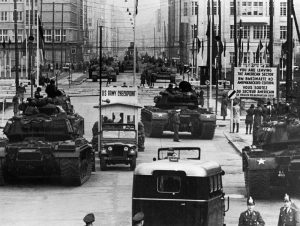 battle over Berlin. In return for Kennedy’s assurance that the west had no designs on East Berlin, the Soviet leader tacitly recognised that allied officials and military personnel would have unimpeded access to the East German capital. From that point on, the western allies freely dispatched diplomats and military personnel to attend the opera and theater in East Berlin. Soviet diplomats, too, attended functions in West Berlin and sent Volga limousines packed with Soviet military police on patrol to West Berlin. The elaborate routine served to prove that the Four Power status of the city was intact. It was faithfully observed until the Wall fell in 1990. they weren’t as eager to start World War III as they thoughts they were.
battle over Berlin. In return for Kennedy’s assurance that the west had no designs on East Berlin, the Soviet leader tacitly recognised that allied officials and military personnel would have unimpeded access to the East German capital. From that point on, the western allies freely dispatched diplomats and military personnel to attend the opera and theater in East Berlin. Soviet diplomats, too, attended functions in West Berlin and sent Volga limousines packed with Soviet military police on patrol to West Berlin. The elaborate routine served to prove that the Four Power status of the city was intact. It was faithfully observed until the Wall fell in 1990. they weren’t as eager to start World War III as they thoughts they were.
 Jumping out of a plane with a parachute, while not something I would consider doing, has become a favorite pastime for many people, but the original parachute jump was not from an airplane. The first noteworthy parachute jump was made by André-Jacques Garnerin from a hydrogen balloon 3,200 feet above Paris. Apparently, Leonardo da Vinci first conceived the idea of the parachute in his writings, and Frenchman, Louis-Sebastien Lenormand fashioned a kind of parachute out of two umbrellas and jumped from a tree in 1783. But, Garnerin was the first person to actually design and test parachutes capable of slowing a man’s fall from an altitude higher than a tree.
Jumping out of a plane with a parachute, while not something I would consider doing, has become a favorite pastime for many people, but the original parachute jump was not from an airplane. The first noteworthy parachute jump was made by André-Jacques Garnerin from a hydrogen balloon 3,200 feet above Paris. Apparently, Leonardo da Vinci first conceived the idea of the parachute in his writings, and Frenchman, Louis-Sebastien Lenormand fashioned a kind of parachute out of two umbrellas and jumped from a tree in 1783. But, Garnerin was the first person to actually design and test parachutes capable of slowing a man’s fall from an altitude higher than a tree.
I can almost hear the wheels turning in Garnerin’s head, as he first pondered the possibility of using air resistance to slow an individual’s fall from a high altitude, while he was a prisoner of war during the French Revolution. Although he never employed a parachute to escape from the high ramparts of the Hungarian prison where he spent three years, Garnerin never lost interest in the concept of the parachute. In 1797, he completed his first parachute, a canopy 23 feet in diameter and attached to a basket with suspension lines.
On October 22, 1797, Garnerin attached the parachute to a hydrogen balloon and ascended to an altitude of 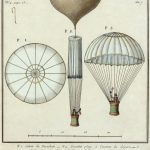 3,200 feet. He then climbed into the basket and severed the parachute from the balloon. Parachutes need an air vent in the top, unbeknownst to Garnerin. As he failed to include said air vent at the top of the prototype, Garnerin’s parachute oscillated wildly in his descent. He landed shaken but unhurt half a mile from the balloon’s takeoff site. In 1799, Garnerin’s wife, Jeanne-Genevieve, became the first female parachutist. In 1802, Garnerin made a spectacular jump from 8,000 feet during an exhibition in England. He died in a balloon accident in 1823 while preparing to test a new parachute. I suppose it could be said that he died doing what he loved. Nevertheless, it would be an awful way to go, if you ask me.
3,200 feet. He then climbed into the basket and severed the parachute from the balloon. Parachutes need an air vent in the top, unbeknownst to Garnerin. As he failed to include said air vent at the top of the prototype, Garnerin’s parachute oscillated wildly in his descent. He landed shaken but unhurt half a mile from the balloon’s takeoff site. In 1799, Garnerin’s wife, Jeanne-Genevieve, became the first female parachutist. In 1802, Garnerin made a spectacular jump from 8,000 feet during an exhibition in England. He died in a balloon accident in 1823 while preparing to test a new parachute. I suppose it could be said that he died doing what he loved. Nevertheless, it would be an awful way to go, if you ask me.
 Today is National Sweetest Day, and it is not to be confused with Valentine’s Day. Where Valentine’s Day is is for people in love. National Sweetest Day got its beginnings, through a holiday founded by the National Confectioners’ Association in 1916 called Candy Day. On October 14, 1916, candy shops around the country filled newspapers announcing their sweetest treats and delights. National Sweetest Day is a day that encourages everyone to be generous even in the smallest ways. It reminds us that even small tokens of kindness improve the lives of those around us, who are suffering or going without. The day might have begun with candy and sweets, and may have encouraged us to take home sweets to our sweethearts and friends…similar to Valentine’s Day, but evolved into something very different. The earliest mentions of the “Sweetest Day of the Year” were in several advertisements found in Indiana, Minnesota, and Texas newspapers. It was not the official name of the day…not yet. In 1917 with war raging in Europe, many retailers encouraged patrons to “Get one for yourself and one for the boys overseas!”
Today is National Sweetest Day, and it is not to be confused with Valentine’s Day. Where Valentine’s Day is is for people in love. National Sweetest Day got its beginnings, through a holiday founded by the National Confectioners’ Association in 1916 called Candy Day. On October 14, 1916, candy shops around the country filled newspapers announcing their sweetest treats and delights. National Sweetest Day is a day that encourages everyone to be generous even in the smallest ways. It reminds us that even small tokens of kindness improve the lives of those around us, who are suffering or going without. The day might have begun with candy and sweets, and may have encouraged us to take home sweets to our sweethearts and friends…similar to Valentine’s Day, but evolved into something very different. The earliest mentions of the “Sweetest Day of the Year” were in several advertisements found in Indiana, Minnesota, and Texas newspapers. It was not the official name of the day…not yet. In 1917 with war raging in Europe, many retailers encouraged patrons to “Get one for yourself and one for the boys overseas!”
By April of 1918, the United States officially entered the war in Europe and with that came rationing. Sugar, as well as many other commodities, became scarce. The holiday that was starting to see such success was shelved. With the end of the war in 1919, sweetness returned to October. So sweet in fact, Candy Day became an entire week. Then in 1923, the day kicked into the full charitable swing. Sweetest Day’s theme of charity and giving became apparent in 1921 when the Detroit Retail Confectioners, Detroit Wholesale Confections Club, Detroit Jobbing Confectioners Association and the Michigan Confectioners Club joined forces with the Red Cross to distribute thousands of bags of candy to hospitals, orphanages, shelters and homes across Michigan. The celebration also included 100 regulation army target balloons which dropped coupons worth a box of candy. In 1929, Sweetest Day settled into its current home, the third Saturday in October.
Now, National Sweetest Day is a day to take care of all those who need care. The theory is that even those who need a lot of care, when given the smallest token of kindness will feel the effects. We have seen that in the many videos where someone brings a meal to a homeless person. A little treat, a card, a show of support during a time of need may be the sweetest gift on this day. Of course, a card would not do much for a homeless, and candy wouldn’t do much for them either, but a piece of candy would put a smile on their face,  simply because it would be so unexpected. National Sweetest Day could also be a day for random acts of kindness. A day do something nice for someone else. There is so little of that in the world in this day and age, and maybe what started out as a specific day to do something nice for others, could eventually become a daily random acts of kindness day. Originally designated to be celebrated the second Saturday of every October, the confectioners’ convention in Detroit in May of 1916 made the final resolution. Walter C. Hughes, the secretary of the National Confectioners’ Association, encouraged Americans to patronizes their local candy shops, bakers, and druggist for the highest quality confections.
simply because it would be so unexpected. National Sweetest Day could also be a day for random acts of kindness. A day do something nice for someone else. There is so little of that in the world in this day and age, and maybe what started out as a specific day to do something nice for others, could eventually become a daily random acts of kindness day. Originally designated to be celebrated the second Saturday of every October, the confectioners’ convention in Detroit in May of 1916 made the final resolution. Walter C. Hughes, the secretary of the National Confectioners’ Association, encouraged Americans to patronizes their local candy shops, bakers, and druggist for the highest quality confections.
 I’m sure that most you have heard of the theory of Six Degrees of Separation, but in case you haven’t, it is the idea that all living things and everything else in the world are six or fewer steps away from each other, so that a chain of “a friend of a friend” statements can be made to connect any two people in a maximum of six steps. I can’t say that I have ever doubted that idea, but I really never gave it much thought really. The idea was originally set out by Frigyes Karinthy in 1929 and popularized in an eponymous 1990 play written by John Guare. It is sometimes generalized to the average social distance being logarithmic in the size of the population. It is all about what a small world it is. That each person is connected to every other person by just 6 steps. It was something I never have given much thought to.
I’m sure that most you have heard of the theory of Six Degrees of Separation, but in case you haven’t, it is the idea that all living things and everything else in the world are six or fewer steps away from each other, so that a chain of “a friend of a friend” statements can be made to connect any two people in a maximum of six steps. I can’t say that I have ever doubted that idea, but I really never gave it much thought really. The idea was originally set out by Frigyes Karinthy in 1929 and popularized in an eponymous 1990 play written by John Guare. It is sometimes generalized to the average social distance being logarithmic in the size of the population. It is all about what a small world it is. That each person is connected to every other person by just 6 steps. It was something I never have given much thought to.
As I became interested in family history, I could see how that could work in the grand scheme of things, with relation. I came across people who were related to me, as well as, being related to my husband. Those relationships had meaning to me and it also made me think about the six degrees of separation that I had heard about years before.
But the reality is that the six degrees of separation never became so obvious to me as last Sunday when my husband had a heart attack. Instantly, we had a group of people around us. Of those people, all concerned for my husband, I knew no one. I only knew that the two women were nurses, and there was a young man who had seen my husband fall. Somewhere in the parking lot was also a woman who knew she needed to pray for him. When we left for the hospital in the ambulance, I thanked the man from across the distance between us in the parking lot, but I still didn’t know his name. I had no idea how I would ever find out who these people were. I knew they were all heroes, and I didn’t know them. Then the six degrees of separation came into play.
First, my husband was saved, and that was a miracle. It was because of 4 people I not only didn’t know, but had now way of finding. They did what they needed to do, and left expecting nothing in return. We owed them so much, and had no way to thank them. Enter the six degrees of separation. I told my husband’s nurse about what had happened, and when her relief came on the next day, she told her about it, and Stephanie, the day nurse already had the first connection for us. The first nurse to help, Ginger, was her sister. And Ginger had the second connection, because she knew the second nurse, Val. Within a few hours, 2 out of the 4 were now known to us. When when I posted about my husband’s miraculous recovery, our friend, Sierra Schamber tagged someone. It was Sean, the young man who helped him first. Then, a woman named Chelsea called her dad to pray. My boss called a prayer partner, who just happened to be on the wife of Chelsea’s dad. I know all those heroes. I think I fully understand the six degrees of separation.

